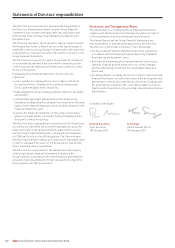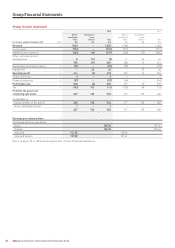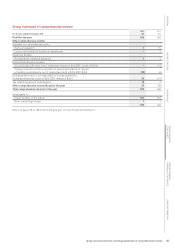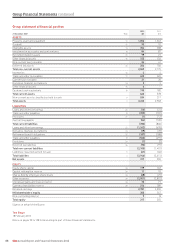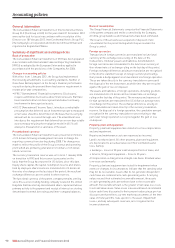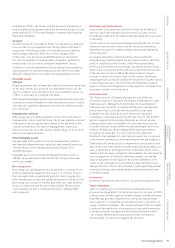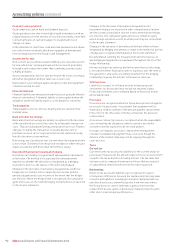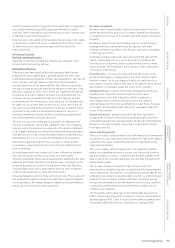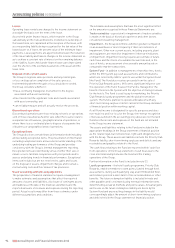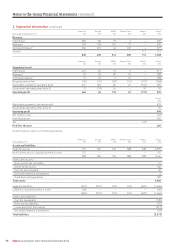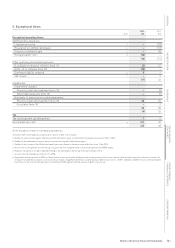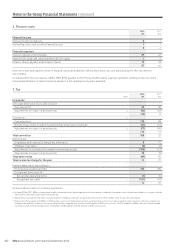Holiday Inn 2012 Annual Report Download - page 94
Download and view the complete annual report
Please find page 94 of the 2012 Holiday Inn annual report below. You can navigate through the pages in the report by either clicking on the pages listed below, or by using the keyword search tool below to find specific information within the annual report.
92 IHG Annual Report and Financial Statements 2012
Cash and cash equivalents
Cash comprises cash in hand and demand deposits.
Cash equivalents are short-term highly liquid investments with an
original maturity of three months or less that are readily convertible
to known amounts of cash and subject to insignificant risk of
changes in value.
In the statement of cash flows, cash and cash equivalents are shown
net of short-term overdrafts which are repayable on demand and
form an integral part of the Group’s cash management.
Assets held for sale
Non-current assets and associated liabilities are classified as held
for sale when their carrying amount will be recovered principally
through a sale transaction rather than continuing use and a sale
is highly probable.
Assets designated as held for sale are held at the lower of carrying
amount at designation and fair value less costs to sell.
Depreciation is not charged against property, plant and equipment
classified as held for sale.
Financial liabilities
Financial liabilities are measured at amortised cost using the effective
interest rate method. A financial liability is derecognised when the
obligation under the liability expires, is discharged or cancelled.
Trade payables
Trade payables are non-interest-bearing and are stated at their
nominal value.
Bank and other borrowings
Bank and other borrowings are initially recognised at the fair value
of the consideration received less directly attributable transaction
costs. They are subsequently measured at amortised cost. Finance
charges, including the transaction costs and any discount or
premium on issue, are recognised in the income statement using
the effective interest rate method.
Borrowings are classified as non-current when the repayment date
is more than 12 months from the period-end date or where they are
drawn on a facility with more than 12 months to expiry.
Derivative financial instruments and hedging
Derivatives are initially recognised and subsequently remeasured
at fair value. The method of recognising the remeasurement
depends on whether the derivative is designated as a hedging
instrument, and if so, the nature of the item being hedged.
Changes in the fair value of derivatives designated as cash flow
hedges are recorded in other comprehensive income and the
unrealised gains and losses reserve to the extent that the hedges
are effective. When the hedged item is recognised, the cumulative
gains and losses on the related hedging instrument are reclassified
to the income statement.
Changes in the fair value of derivatives designated as net
investment hedges are recorded in other comprehensive income
and the currency translation reserve to the extent that the hedges
are effective. The cumulative gains and losses remain in equity
until a foreign operation is sold, at which point they are reclassified
to the income statement.
Changes in the fair value of derivatives which have either not been
designated as hedging instruments or relate to the ineffective portion
of hedges are recognised immediately in the income statement.
Documentation outlining the measurement and effectiveness of
any hedging arrangements is maintained throughout the life of the
hedge relationship.
Interest arising from currency derivatives and interest rate swaps
is recorded in either financial income or expenses over the term of
the agreement, unless the accounting treatment for the hedging
relationship requires the interest to be taken to reserves.
Self insurance
Liabilities in respect of self insured risks include projected
settlements for known and incurred but not reported claims.
Projected settlements are estimated based on historical trends
and actuarial data.
Provisions
Provisions are recognised when the Group has a present obligation
as a result of a past event, it is probable that a payment will be
made and a reliable estimate of the amount payable can be made.
If the effect of the time value of money is material, the provision
is discounted.
An onerous contract provision is recognised when the unavoidable
costs of meeting the obligations under a contract exceed the
economic benefits expected to be received under it.
In respect of litigation, provision is made when management
consider it probable that payment may occur even though the
defence of the related claim may still be ongoing through the
court process.
Taxes
Current tax
Current income tax assets and liabilities for the current and prior
periods are measured at the amount expected to be recovered from
or paid to the tax authorities including interest. The tax rates and
tax laws used to compute the amount are those that are enacted
or substantively enacted by the end of the reporting period.
Deferred tax
Deferred tax assets and liabilities are recognised in respect
of temporary differences between the tax base and carrying value
of assets and liabilities including accelerated capital allowances,
unrelieved tax losses, unremitted profits from overseas where
the Group does not control remittance, gains rolled over into
replacement assets, gains on previously revalued properties and
other short-term temporary differences.
Accounting policies continued


